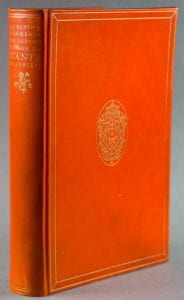‘A book full of anxieties’: The Nonesuch Press edition of Dante’s Divine Comedy
By Erika Delbecque, on 3 May 2019
The production of the 1928 Nonesuch Press edition of Dante’s Divine Comedy was beset with difficulties. The handmade paper from Italy that had been ordered was so defective that it was unusable, and the stained orange calfskin that was used for the binding, which naturally shrinks and extends in reaction to changes in temperature and humidity, made the boards warp. Francis Meynell, one of the founders of the Press, wrote that ‘it has been a book more full of anxieties than any I have ever tackled’ (Quoted in Dreyfus, p. 46). Nevertheless, the book became an unprecedented success for the Nonesuch Press; it was the most oversubscribed of all of their publications.
Meynell founded the Nonesuch Press imprint in 1923 with his wife, Vera Mendel, and the writer David Garnett, with the aim of applying advances in mechanical book production to fine book printing. As opposed to the private presses of the late 19th and early 20th centuries, which according to Meynell produced prohibitively expensive books intended to grace library shelves rather than to be read, the aim of the Nonesuch Press was to produce well-made appealing books that were available at relatively low prices. They specialised in carefully designed editions of established literary works, often illustrated by contemporary artists.
Their edition of the Divine Comedy, of which 1,475 copies were printed, presents Dante’s Italian text alongside an English translation. The italic type and the use of roman capitals to mark the start of each line was inspired by the page design of Venetian books from the early sixteenth century. Meynell preferred to use italic fonts for poetry as he felt that it encouraged the reader to slow down. The volume includes 42 illustrations after the famous Renaissance painter and fellow Florentine Botticelli. He designed 19 engravings for Nicholo di Lorenzo della Magna’s 1481 edition of the Divine Comedy, of which we also hold a copy (INCUNABULA FOLIO 6 b ), and he illustrated a late 15th-century manuscript of the work with 92 drawings.
The book will be added to our unrivalled Dante collection, which comprises of over 4,000 editions of Dante’s work from the fifteenth century to the present day. When the Nonesuch Press edition was published, a reviewer wrote in the Spectator that he hoped that the copies would not go to ‘those perverse bibliophiles who thwart the holy intention of books by locking them uncut upon their jealous shelves’ (Quoted in Dreyfus, p. 46). He can rest assured when it comes to copy number 868 – it has joined fellow Dante editions on our shelves, waiting to be requested by eager readers.
Further reading
Dreyfus, John. A history of the Nonesuch Press. London: Nonesuch Press, 1981.
 Close
Close





